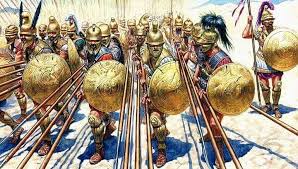Vaša košarica je trenutno prazna!
Introduction: The Legend of the Tireless Soldiers
The Macedonian phalanx, made famous by Philip II and Alexander the Great, is known for its formidable spear formations, disciplined tactics, and unbreakable unity. One of the most enduring stories about these ancient warriors is the claim that Macedonian phalangites trained by marching 60 kilometers in full armor—a feat that would challenge even modern infantry. But how much truth is there to this historical claim? Were these soldiers truly capable of such intense physical endurance? Let’s delve into the historical sources, military practices, and logistics behind this fascinating myth.
Who Were the Macedonian Phalangites?
Phalangites were the core infantry of the Macedonian army, equipped with the iconic sarissa—a spear roughly 4 to 6 meters long. Unlike Greek hoplites who used shorter spears and fought in tight shield walls, phalangites relied on overlapping rows of long spears to create a bristling wall of death. They wore bronze or iron helmets, linothorax armor, carried a small round shield (pelte), and often wore greaves for leg protection. Their formation, known as the phalanx, was nearly impenetrable from the front. These soldiers were not just brutes—they were highly trained professionals, drilled rigorously in marching, maneuvering, and holding formation.
The 60 km March: Fact or Military Propaganda?
The claim that phalangites could march 60 kilometers (37 miles) in a single day wearing full armor is often repeated in modern accounts, but its historical basis is not fully verified. No direct quote from ancient sources such as Arrian, Plutarch, or Diodorus Siculus explicitly confirms the distance. However, Alexander the Great’s campaigns did involve long forced marches under extreme conditions. Some historians believe the 60 km number may derive from logistical calculations and Roman-era military standards, retroactively applied to Macedonian troops.
Still, there’s no doubt the phalangites trained for endurance. Alexander once reportedly marched his troops 40 km (25 miles) through the Gedrosian Desert, a feat that tested the limits of stamina and discipline. While a 60 km march in armor may have been rare, shorter but still demanding marches were absolutely part of their regimen.
Physical Conditioning of Macedonian Troops
Alexander the Great was known for personally leading his men in brutal marches and sharing their hardships. His philosophy was that a soldier who suffers in training bleeds less in battle. Macedonian phalangites trained:
-
In heavy armor, often under the summer sun
-
With their sarissas held aloft for hours
-
To execute complex battlefield formations while fatigued
-
In rapid forced marches, sometimes without full supplies
Their diet was simple but designed for endurance, consisting of grains, meat, and fermented beverages. Most importantly, discipline and morale were instilled from youth, especially in the pezhetairoi—elite foot companions of Alexander’s army.
Comparison with Modern Military Standards
Modern infantry soldiers can march 20–40 km per day with gear weighing 25–35 kg. Historical accounts suggest Macedonian soldiers carried 15–25 kg, including armor, weapons, and rations. Therefore, a 30–40 km march would have been feasible under optimal conditions. 60 km would be extraordinary, but perhaps achievable during emergency forced marches or with reduced gear.
The training was less about the daily distance and more about mental and physical resilience. This endurance allowed Alexander’s army to fight multiple battles in quick succession, cross deserts, and traverse mountains—something no lightly trained force could manage.
Tactical Reasoning: Why Endurance Mattered
Speed and maneuverability were central to Alexander’s military strategy. His forces had to:
-
Rapidly redeploy across long distances
-
Flank enemy positions before reinforcements arrived
-
Cross difficult terrain such as rivers and deserts
-
Surprise enemies with speed and unexpected force
Hence, conditioning soldiers through long marches was critical. Even if 60 km wasn’t a daily standard, training for such extreme scenarios gave the Macedonian phalanx a serious strategic edge.
Myth vs. Reality: The Balanced View
-
Myth: Phalangites routinely marched 60 km in armor
-
✅ Reality: No ancient source confirms this exact number, but forced marches over long distances were absolutely part of training
-
Myth: Phalangites were heavily burdened and slow
-
✅ Reality: They were mobile, well-trained, and more enduring than typical hoplites
-
Myth: Only cavalry moved quickly
-
✅ Reality: Infantry under Alexander was surprisingly mobile, enabling complex battlefield maneuvers
Conclusion: A Legacy of Endurance and Discipline
Whether or not 60 km in armor was standard, there is no denying the endurance, discipline, and resilience of the Macedonian phalangites. These soldiers helped Alexander forge one of the largest empires in history—not only through superior weapons but through sheer physical and mental toughness. The legend reflects the admiration of ancient and modern historians for what this army could achieve. In many ways, the story of the 60 km march symbolizes the spirit of a military force that reshaped the ancient world.
Explore more historical war machines on our Legends and Myths site.

